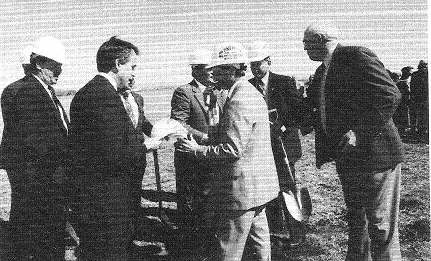
|
 |

|
|---|

[ Groundbreaking - Alva Drug Offenders Work Camp ]
3.0 – MATHEMATICAL CALCULATIONS
--- THE VARIOUS METHODOLOGIES
Yet once again, while the authors of this report are (obviously) against the prohibition laws; Still, what we seek are honest and truthful statistics. And should the reader have doubts, logic and reason will dictate that any errors on our part will be quickly noted and used by our enemies to ridicule and belittle us. Thus ironically, it is the enemies of freedom who force this report to contain honest and fair statistics.
|
|---|
3.1 - CALCULATING THE AVERAGE COST PER PRISONER PER YEAR:
How much is it costing the Oklahoma taxpayers to incarcerate a prisoner for a year?
As stated previously, there is much room for statistical debate on this very question. So let us start by looking into the two financial extremes: Those being the very minimum and the very maximum figures.
THE MINIUM:
By far the cheapest way of incarcerating state prisoners is by making use of local/county jail facilities. According the Department of Correction’s own Annual Report for the Year 2013:
“The daily charge to the Department by the counties for offenders housed in county jails is set by statute and is currently set at $27 plus all medical costs.”Which assuming 365 days per year comes out to only (365 x $27) = $9, 855 per prisoner per year. To which however, we must add $3,935 (which is the average medical costs per inmate per year), [8] so the total then becomes ($9, 855 + $3,935) = $13,790.
So technically, the absolute cheapest cost of incarcerating a prisoner at the state level is to deport him to a local county Jail facility where the cost’s only average around $13,790 dollars per inmate -- HOWEVER, it should be noted that more than one county sheriff has gone on record as stating that these charges (set by State law quite a while back) are simply not enough to cover costs. Thus we may see an increase coming up to road.
THE MAXIMUM:
At the other financial extreme are figures that are being dabbled about by state officials. And those are:
Which using ODOC (Oklahoma Department of Corrections) 2013 Annual Report statistics (26,539 incarcerated offenders) would mean:
| GENDER | PERCENTAGE | NUMBER(S) | COSTS |
| MALE | = 89.8% | = 23,832 male prisoners | = $440,892,407 |
| Female | = 10.2% | = 2,707 female prisoners | = $62,260,494 |
The problem here is that the total appropriation budget for that year was only $463,731,068. However, there is usually extra funding provided somewhere along the way by the state legislature AND the financial benefits of Prison Labor (or slave labor depending upon your political viewpoint) must also be taken into account. So it is indeed possible that the total sum can indeed come out to around $503,152,901.
Thus averaging Male/Female prisoners out ($503,152,901 / 26,539) = $18,959 per prisoner per year. This constitutes the highest possible yearly costs per prisoner incarceration.
Thus we have our two extreme points:
For the purposes of this report we have chosen to use a figure of $15,167, as being the average cost of incarcerating each state inmate per year. A figure that was derived by taking the total budget for the Department of Corrections but subtracting 20% to take into account Office overhead and other managerial/accounting costs. Then using the remaining 80%, dividing that by the total number of state prisoners being incarcerated. A figure that calculates to $15,167 per prisoner per year.
Another figure that we could have chosen was $16,375 (which is the mid-point between the two extreme figures. However, (again) for the purposes of this report, the lower figure of $15,167 per prisoner per year will be used.
Granted, there is much room for (ah), statistical debate but as that old expression goes; – “If we are to err, let us therefore do so on the side of caution.”
|
|---|
3.2 --- DEFINING BASIC PRESUMPTIONS:
As the calculations found throughout this report will make use of certain (both mathematical as well as theoretical) presumptions. Perhaps it would be best to spend some time (now before any heavy math) going over these presumptions defining exactly what is meant.
3.2.1 -- DEFINITION
- What Exactly Constitutes A Marihuana Prisoner?
What at first would seem obvious is not so obvious when one starts doing tabulations. No doubt, some purists might claim that it constitutes SOLELY OF those incarcerated for Marihuana possession and nothing else.* HOWEVER, this definition simply ignores the reality that is Oklahoma. Referencing a hypothetical (but all too realistic) example of (let us say) a Cancer patient (on his way to obtain chemotherapy treatment), who’s stopped and arrested for one lone Medical Cannabis cigarette. One would think that he would be charged with simple possession --- but here in Oklahoma, THINK AGAIN. Quite literally, he could (and most assuredly will be) charged with many of the following (Marihuana Law) related crimes:
- Possession of Marihuana
- Possession of Drug Paraphernalia (meaning the cigarette paper)
- Trafficking / Intention to Sell – This law has no exact definition, and can mean almost anything a cop or prosecutor says that it means.
- Being so many feet from a public school (or drinking fountain, or whatever) – where children have been known to congregate.
- Possession of a deadly weapon, while committing a felony; ---meaning he had a pocket knife (or a toothpick, whatever) on him at the time.
- Conspiracy to commit a crime (after all he had to obtain his marihuana cigarette from some one), thus in a conspiracy to proform illegal activies, etc.
- And more . . . [See Addendum-B]
Thus this report defines a prisoner as being incarcerated “SOLELY” for Marihuana IF all the other alleged offences were also Marihuana related. That is to say, if Marihuana were NOT AGAINST the law in the first place, then all of the other (so-called) offenses would also not have been against the law in the first place.
Granted, this definition can and does lead to some awkward situations. For example (not very long ago in Texas) a homeowner was awoken by the noise of someone braking into his home in the middle of the night. Thinking that he was being attacked and robbed, he took out his handgun and shot the intruder dead in the dark. --- As it turned out, the intruder was a lone Sheriffs Deputy who was serving a warrant for a possible Medical Marihuana Crime. Ooops. --- But be that as it may, we have to ask ourselves the question, IF MARIHUANA WERE NOT AGAINST THE LAW, would the other situations (also classified as offences) have taken place? The answer, while uncomfortable is obvious. Even the Texas judicial system took the same approach, decided that the homeowner was well within his rights to have defended himself.
In addition we are also classifying “Parolee Violators” who are returned to prison for some offence that HAD THEY NOT originally been jailed for Marihuana, would NOT HAVE BEEN an offence at all. etc.
* In reality (while not in extremes), there actually are quite a few Oklahomans in jail solely for “Possession of Marihuana. ”-- See Addendum-A for a partial listing of those we've been able to identify as such.
3.2.2 -- DEFINITION
- What Constitutes A Partial Marihuana Prisoner?
Because this IS a financial report, we are forced to think in terms of “HOW MUCH” is it costing us to maintain a prisoner who is under incarceration for MORE than just marihuana related crimes. In other words, an individual who would still have ended up in prison EVEN if the prohibition laws did not exist. This is someone who is in jail for crimes OTHER than those associated with Marihuana. And let's face facts many of these individuals would still be doing jail time, just because of the kind of people that they are.
But it is interesting to note that some of them were able to get away with it, for quite some time, by simply threatening the youngsters with the possibility of being arrested for Marihuana use IF THEY TOLD ANYONE. --- Again, some people are just human garbage. But hopefully (once legal), this situation will finally be brought to an end. |
|---|
HOWEVER, be that as it may, and recalling that this is an economical report (devoiding itself of all ethical and moral issues), we must still note that MARIHUANA is at least one of the reasons why they are in jail. And as such one must deem them to be “Partial Marihuana prisoners” and as such have an economic impact on the Oklahoma Taxpayer.
EXAMPLE: If a prisoner is serving a sentence of 4 years for crimes A, B, and C and another 2 years for possession of Marihuana. Then (for economic reasoning) we must view or count him or her as being 1/3 (one third) of a regular Marihuana prisoner. After all aren’t the taxpayers on the hook for one-third of that prison sentence. However, this example (while hypothetical) also hints at a serious problem faced by this report. That being that NOT ALL “partial Marihuana Prisoners” fit neatly into a fixed percentage category and even if they did, the exact percentages will vary widely.
Using some hypothetical examples:
- A conviction for possession of both Marihuana and Morphine
Given our state laws, this prisoner will most likely be serving a sentence (50% for Marihuana and 50% for Morphine) which means that she (technically) constitutes only one-half of normal Marihuana Prisoner.
- A medical patient (in great pain) is convicted of both possession of Marihuana as well as unprescribed Oxycon
This case also shows the pittfalls of our definition. In almost any other state this patient would at least have been prescribed proper pain medication, but again this is Oklahoma. Thus given our state laws, and as the conviction was for two offences, we must assume that this prisoner is only service half his sentence of possession of Medical Marihuana. Meaning that she will (technically) only constitute one-half of normal Marihuana Prisoner.
- Armed robbery and possession of Marihuana.
Although armed robbery seems to be a more serious offense, here in Oklahoma this individual could be given a sentence of 3 years for robbery and 6 years for Marihuana. Thus he (technically) would constitute only two-thirds of a normal Marihuana prisoner.
- Sale of stolen property, Heroin, Meth, Cocaine, Oxycon and Marihuana
As Frank Zeppa would have put it, this guy was in it solely for the money. However, here note that no matter how one looks at it, Marihuana does makes up one of his offenses. Thus he or she (technically) qualifies (at least statistically) as a partial Marihuana prisoner.
- Possession of stolen goods, and Marihuana.
Here again (this being Oklahoma), we have a situation where it is possible for the individual to be given more time for Marihuana possession than for the stolen goods. But for the sake of argument, let’s include this individual as being one-half of a normal Marihuana prisoner.
- Murder one and possession of Marihuana.
We’ve added this one to show some of the pit-falls with our definition. Technically this guy is doing life in prison BUT still Marihuana is one of the offenses and as such must be counted in someway.
Which is why (for the purpose of this report), we have chosen to count each “Partial Marihuana Prisoner” as having the same (economic) weight. ---That being one-forth of a regular prisoner. Why one-forth? Simply put, because of the laws of averages. Granted, many of the multiple crime offenders are in prison for a whole lot of crimes, still there are many others that are only in their for two crimes (say Marihuana and possession of stolen property) and as such (statistically) it appears that everything averages out to four different offenses per Partial Marihuana Prison.
3.2.3 -- DEFINITION
- What Constitutes a Sort of Marihuana Prisoner?
There is yet another group of (what one might assume as being) Partial Marihuana Prisoners that needs to be addressed. This group constituting of those under incarceration totally for non-Marihuana related crimes, BUT who are in prison for Marihuana anyway. Perhaps it would be best to explain via examples.
THE THREE STRIKES AND YOUR OUT OFFENDERS:
Larry Yarbrough (ODOC# 125218), is presently serving a “Life Without Possibility of Parole, under Oklahoma’s three strikes and you’re out law. However, all three-felony convictions were for CDS charges and at least one of those three strikes was solely for Marihuana. --- Thus, where does one (for financial purposes) place him? Obviously he is there because of the Marihuana prohibition laws BUT at the same time, he is not!
SYNTHETIC SUBSTANCES:
For our purposes (although a synthetic could be a lot of things), we are talking about a plant that is a substitute for Marihuana. QUESTION: If the Marihuana prohibition laws were not in place, would anyone be having anything to do with a synthetic substitute?
ESCAPED PRISONERS:
One would think that an escaped Marihuana prisoner would NOT be a burden to the taxpayer (well maybe to law enforcement officials but not to the state prison system). And while it is true that s/he is not actually using a prison bed, nor eating prison food, nor .. . etc. Still it appears that the escapee is still using up administrative time as well as other paper work functions. – Recall that another one of our presumptions was that 20% of the total prison budget was to be used for administrative NOT prisoner maintenance. [Sec. 3.1 - this report]
HISTORICAL MARIHUANA USE:
Consisting of those whose offences were so small that under normal circumstances the Judges would have simply let them out on parole were it not for a previous or present Marihuana arrest.
And the various other “Sort-of Marihuana Prisoner” sub-classifications which (for financial purposes) exist but otherwise escape the world of paper work. [A subject which, at a later time, we will give more attention]
3.2.4 -- DEFINITION
– NON-VICTIMLESS, VICTIMLESS CRIMES
There is general agreement among most that Marihuana (of and by itself) constitutes a victimless crime. Meaning a criminal activity without a victim. Or what in the vernacular of the 1930’s was termed, “A Man Made Law.”
Granted, at the time they were originally being passed in the 1930’s, the public was being told by both State and Federal officials that Marihuana’s use, led to sure insanity and acts of violence on the part of its users. That individuals were jumping out of fifth story windows as a result of its hideous use, etc. Perhaps the following encyclopedic definition explains best:

WEBSTERS ENCYCLOPEDIC DICTIONARY OF THE ENGLISH LANGUAGE
And while many of us would like to view the above (like slavery, Jim Crow, etc.), as being part of our historical past best forgotten, it is a fact that the Marihuana Laws are still with us today. In fact Oklahoma is known as the home of the 93-year prison sentence for Medical Marihuana use. And it can be agreed that Marihuana related crimes (activities that are illegal solely because Marihuana itself is illegal), therefore they can also be viewed as being victimless. But what about Marihuana law violations, in conjunction with, more serious offenses; Offenses that clearly do have a victim?
One is tempted (at first) to simply say that such cases constitute real crimes and that those individuals incarcerated as such should (at best) be seen as ONLY BEING PARTIAL MARIHUANA PRISONERS. However, here in Oklahoma, things (or at least the way our laws work) ARE NOT SO SIMPLE. For example, most agree that “Car theft” (which is often associated with Marihuana arrests) is NOT a victimless crime by any measure, or it is?
- EXAMPLE: -- Let’s say that you allowed a family member to borrow your car. Later on that night you find out that he was arrested for Marihuana and the cops want to know if you knew anything about it. Now heres the problem, if you say “YES, I knew he was going to go out and buy some Marihuana,” then “ALA AKBAR KA-BOOM,” you’ll now face arrest yourself for being an accessory to the crime, not to mention that your car will then be inpounded or seized under drug forfeiture asset laws, etc. So obviously you’re going to say that, “NO that you knew nothing about it”. But here-in lies the problem, --- Here in Oklahoma we have an “UNAUTHORIZED USE OF A VEHICLE LAW” on the books (Code - 47-4-102), which in effect makes it a crime to use someone else’s vehicle to committee a crime like (let us say) simply transporting Medical Marihuana etc. --- TRANSLATION, yet another criminal charge is now added to the arresties rap sheet. And what would normally have been seen as a VICTIMLESS crime now (at least on paper) appears like an actual crime. --- PLEASE NOTE: This is a very commonly used tactic over here in Oklahoma, NOT just something that occurs every now and then.
- EXAMPLE: -- Now let’s look at yet another automobile law example, this time “RECEIPT / POSSESSION / CONCEALMENT OF A STOLEN VEHICLE” (Code 47-4-103). At first glance this one should be quite simple, such and such an individual stole a car, END OF STORY; --- But wait this is Oklahoma remember. What if the vehicle in question had been lent out to a friend, NOT a direct family member (say, a cancer patient needing it to pick up some Medical Marihuana), etc. Here the situation can then get quite sticky, real quick. In this case the car owner herself might also end up behind bars, for “Conspiracy to Commit a Crime” etc., and thus there is a tendency to respond to police questions with something like; “Oh No, I didn’t even know he had taken my car, etc.” And, thus a stolen vehicle charge is now added on to the arrest report.
- EXAMPLE: -- SMUGGLED CONTRABAND INSIDE A PRISON INSTITUTION
When one thinks of smuggling Contraband into a prison institution one normally thinks in terms of smuggled hand guns, or rat-tail-files, etc. BUT WAIT, this is Oklahoma and here, it can mean a whole-lot of things. For instance it can mean TOBACCO (and this is not a joke), more than one person has had (yet more) jail time added for “Possession of Tobacco” inside our state prisons. It can also mean Alcohol, or even cell-phones or a whole-whole lot of things.
QUESTION; if Marihuana were NOT against the law in the first place (meaning the prisoner would not have been in the prison in the first place), would these other crimes (like possession of tobacco) have also been against the laws? Or what if it was Marihuana which was the object of the “CONTRABAND into the Jail?”
* ADDENDUM-C; Contains a sample letter sent to the various state agencies.
FOOTNOTES:
[8]- - http://www.koco.com/news/health/prison-health-care-costs-decline-in-oklahoma-report-says/22710848#mid=18432774 --- Published Oct 30, 2013 -- Note that the report was about how Oklahoma had lowered it’s prisoner health care costs per individual prisoner.
 PRISON REPORT PREVIOUS SECTION |
 |
 PRISON REPORT NEXT SECTION |
 PRISON REPORT BACK TO MAIN INDEX PAGE |


